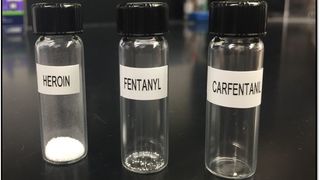Addiction
What Is Fentanyl And Why Should You Care?
Overdose deaths in the U.S. keep rising, the culprit is almost too small to see
Posted February 18, 2019
192 people die of an overdose every day in the U.S., on average.
It’s no secret that the United States is in the midst of an opioid crisis. Just last month there was a mass overdose at a home in a Californian suburb killing one person and hospitalizing another dozen. While heroin and oxycodone were the big players in the opioid market and have been the cause of high numbers of fatal overdoses, they were not to blame this time.
Fentanyl was the culprit there.
It’s a dangerous drug and it’s not one we haven’t heard about before. Between 1999 to 2017, there has been an epidemic of fatal drug overdoses, and it was Fentanyl (and its close cousin, carfentanyl), not heroin or oxycodone that has risen as one of the most commonly seen drugs in fatal overdoses.
What is Fentanyl?
Fentanyl is a synthetic opioid that is eighty to one hundred times stronger than morphine. It has been used for high-level pain relief in cancer (primarily in the form of patches) and in anesthesia cocktails for years. But in the relatively recent past, it has entered the recreational drug market in full force. According to a recent report by the Centers for Disease Control and Prevention, it’s the drug most often involved in fatal overdoses across the United States.
Fentanyl accounts for twenty-nine percent of all overdose deaths (almost a third!) with more than 18,000 fatalities in 2016. Fatal overdoses involving fentanyl rose about 113 percent per year from 2013 to 2016.
More than two-thirds of fentanyl-related deaths involved at least one other drug—a trend likely linked to the fact that drug dealers often lace heroin and cocaine with fentanyl in order to increase potency at a low cost. So when someone buys opioids, it’s possible they are getting a deadly concoction.
Two out of five cocaine-related overdose deaths also involved fentanyl, while nearly one-third of fentanyl-related fatalities also involved heroin.
Where does Fentanyl come from?
Most fentanyl in North America comes from China. Although this isn’t where fentanyl originated, there is a lack of regulations in the pharmacological industry there, which makes China a substantial supplier of illegal prescription drugs worldwide.
The United States put pressure on China to regulate fentanyl but regulation have been problematic to enforce. Underground labs avoid the watchful eye of authorities through fake addresses and illegal locations. Pharmacists can also alter the formula of the substance so that it evades recognition under the list of scheduled drugs.
Fentanyl manufacturing has also been found in drug labs in Mexico, Canada, and the United States.
What are the dangers of Fentanyl?
Firstly, it’s an incredibly strong opioid even in small doses.
"Fentanyl is potentially lethal, even at very low levels. Ingestion of doses as small as 0.25mg can be fatal," US Drug Enforcement Agency (DEA)

The reason Fentanyl is so much stronger than other opiates is because it is substantially more lipophyllic (can move through the fat in tissue much faster) and the fact that it binds to the primary pain-relief opiate receptor (the Mu receptor) 50-100 times more strongly.
It’s highly addictive
Fentanyl is dangerous because the effects, also known as the “high,” lasts for a relatively short time compared to heroin. This means more frequent use is required to maintain the effects, making it more addictive more quickly for many. And people don’t often even now they’re using fentanyl because it’s being mixed in with so many other drugs (like heroin, cocaine and more). That’s one of the primary risks of an underground drug market!
It’s one of the biggest killers in the United States
Alarmingly, in the United States, a person is more likely to die from an accidental opioid overdose than dying in a car accident! Not only that, but the odds of overdosing are higher than the risk of death by drowning, fires, falls and pedestrian accidents. Predicted life expectancy of people in the United States declined from 2016 to 2017 as a result.
It’s more difficult to reverse the effects of an overdose
One of the reasons fentanyl is more likely to result in a fatal overdose than other opioid drugs is because of its greater affinity for my receptors, which require multiple doses of naloxone (LINK: https://www.psychologytoday.com/au/blog/all-about-addiction/201901/prof…) to reverse the effects of the overdose. (LINK: https://www.nbcnews.com/storyline/americas-heroin-epidemic/new-syntheti…)
It’s easy to manufacture and access
Fentanyl is a synthetic drug and so there is no lengthy time required to grow and cultivate organic substances like with other opioids such as heroin. So it is cheap to make and can be sold online directly to the United States or through Mexican trafficking networks. Once received by drug suppliers, fentanyl is often mixed in very small amounts with other substances, usually heroin, which increases the potency, and the associated risks.
Know someone who is using Fentanyl?
If you know someone who is using fentanyl, or in danger of using fentanyl, then here’s what you can do:
- Carry Naloxone if you can. Forty-one states across the United States now make it possible to buy the spray or injection over the counter. This can save someone’s life!
- Educate yourself on the symptoms of overdose. Signs of a potential overdose include: cold or clammy skin, slow or irregular heartbeat or breathing, change in skin color (bluish tinge), lethargy or unconsciousness.
- Be compassionate and understanding. People don’t choose to become addicted to substances, and the reasons behind addiction are complex (see HERE, HERE and HERE for more). If you want to understand why someone you know is using drugs or how to support them in recovery, read The Abstinence Myth.
If you're someone who obtains drugs from illegal sources ALWAYS err on the side of caution and start out with a small dose. Test the drug you're experimenting with. Different batches can contain different mixes of substances and dealers often have NO IDEA what's in their drugs (they don't make it, they sell it, trust me, I’ve been there). So take a very small amount to test the effect and make sure you're not using something adulterated that can kill you.
Demystifying the “accidental death”
Preventable deaths and injuries, like overdoses, are often called “accidents,” implying they are unavoidable acts of God or fate that we are powerless to stop. This is bogus. I'm a firm believer that we can eliminate preventable deaths (such as overdose) by making it easier for people to get the help they need. In the United States, preventable injuries are the 3rd leading cause of death behind heart disease, cancer, and chronic lower respiratory disease.
While governments are working to establish more controls, new chemical substances are produced to get around them. Strict regulations and enforcement do not ensure the absence of the illicit drug market, nor will it stop people accessing dangerous substances.
In addition to pursuing China-based regulations to reduce the flow of Fentanyl (which unfortunately hasn’t proved a suitable solution for cocaine, meth, heroin or any other drug we’ve tried it for) we need to address the growing demand for such drugs if we’re going to have a real impact.
So in addition to educating people about the risks of fentanyl and treating those struggling with addiction we also need to address the reasons why people begin using in the first place. There will always be "war on drugs" if we don't address the "war on loneliness, isolation, stress and trauma." If you want to treat the underlying problem to your addiction without the pressure of abstinence, join the IGNTD Recovery network today.




